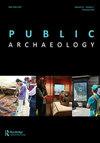Public Archaeology: Theoretical Approaches and Current Practices
IF 0.9
4区 历史学
0 ARCHAEOLOGY
引用次数: 4
Abstract
In the nearly five decades since McGimsey (1972) published Public Archaeology and gave a name to an emerging field of practice, archaeologists wrestling with practical, ethical, and legal imperatives have extended tremendously the domain of public archaeology. McGimsey’s vision was limited and essentially self-serving for the profession: educate the public so they will support us and, perhaps, provide volunteer labour. Two decades later, Schadla-Hall empowered archaeologists to search for the ‘public’ in virtually every element of their practice when he declared that public archaeology is ‘concerned with any area of archaeological activity that interacted or had the potential to interact with the public’ (Schadla-Hall, 1999: 147). By the late 2010s, public archaeology and its concerns have become the subject of university degrees and public mandates are embedded in laws, treaties, and the codes of ethics of professional bodies. Increasingly, public archaeology is begging for some organizing principles to position it in the broader (and itself broadening) discipline of archaeology. Not surprisingly, a cluster of books has emerged that, taken together, constitute first efforts to convert the arguably inchoate practice of public archaeology into a recognizable discipline. That is, to impose some boundaries on the discipline, to initiate development of theories of practice and accepted methodology, and to position public archaeology and its close cousin community archaeology within historical, ethical, and legal issues of concern to archaeologists generally. Merriman’s (2004) volume, also named Public Archaeology, was perhaps the first of these. In recent years, we have seen a growing number of efforts to theorize, codify, and define the boundaries, however broad, of public archaeology. Moshenska (2017; Moshenska & Dhanjal, 2012) has been a driver of this effort, albeit with a largely European focus. Okamura and Matsuda (2012) have extended the range of the discourse to other parts of the globe. Specialists have focused on practice in specific international contexts (e.g. Schmidt & Pikirayi, 2016) or areas of public contact such as educational practice (Bender&Messenger, 2019; Erdman, 2019). Specialized journals such as Public Archaeology, the Journal of Community Archaeology & Heritage, country-specific online public archaeology journals, and a host of specialist heritage publications have further extended the literature. Into this emerging genre, Isi̧lay Gürsu has introduced an intriguing highbred volume, part theoretical and historical overview, part case studies in three Mediterranean contexts (Turkey, Crete, and Italy). As do several of the recent books, this volume touches on the history of the public in archaeology, public archaeological education and engagement, looting and treasure seeking, human rights, the commoditization of heritage and its converse — the economic value of archaeological resources, and the practice of cultural heritage management as it impacts on local communities. What is distinctive about Gürsu’s book is the manner in which it puts a human face on issues and challenges that feel impersonal in much archaeological scholarship. Gürsu’s volume begins with three chapters that focus on the evolution and theoretical foundations of public archaeology. A chapter by Reuben Grima does an admirable job of putting public archaeology in broad historical context, from nineteenth-century interest in colonial public archaeology, Vol. 17 No. 4, November 2018, 214–216公共考古学:理论途径与当前实践
自McGimsey(1972)出版了《公共考古学》(Public Archaeology)并命名了一个新兴的实践领域以来的近50年里,考古学家们在实践、伦理和法律的必要性方面进行了激烈的斗争,极大地扩展了公共考古学的领域。McGimsey的愿景是有限的,本质上是为这个行业服务的:教育公众,这样他们就会支持我们,也许还会提供志愿者。二十年后,Schadla-Hall授权考古学家在他们实践的几乎每一个元素中寻找“公众”,他宣布公共考古学“关注与公众互动或有可能与公众互动的任何考古活动领域”(Schadla-Hall, 1999: 147)。到2010年代末,公共考古及其关注已成为大学学位的主题,公共任务已纳入法律、条约和专业团体的道德准则。越来越多的公共考古学正在乞求一些组织原则,将其定位于更广泛的考古学学科(其本身也在不断扩大)。毫不奇怪,一堆书出现了,它们合在一起,构成了将公共考古学这一有争议的早期实践转变为一门公认的学科的第一次努力。也就是说,给这门学科划定一些界限,开创实践理论和公认方法论的发展,并将公共考古学及其近亲社区考古学置于考古学家普遍关注的历史、伦理和法律问题之中。梅里曼(2004)的卷,也被命名为公共考古学,可能是其中的第一个。近年来,我们看到越来越多的人在努力理论化、编纂和界定公共考古学的边界,不管它有多宽。Moshenska (2017;Moshenska & Dhanjal, 2012)一直是这一努力的推动者,尽管主要关注欧洲。Okamura和Matsuda(2012)将话语范围扩展到全球其他地区。专家们专注于特定国际背景下的实践(如Schmidt & Pikirayi, 2016)或公共接触领域,如教育实践(Bender&Messenger, 2019;Erdman, 2019)。诸如《公共考古学》、《社区考古与遗产杂志》、特定国家的在线公共考古学期刊和大量专业遗产出版物等专业期刊进一步扩展了文献。在这一新兴流派中,Isi æ lay g rsu介绍了一本引人入胜的高级卷,部分是理论和历史概述,部分是三个地中海背景(土耳其,克里特岛和意大利)的案例研究。就像最近的几本书一样,这本书触及了公众在考古学中的历史,公众考古教育和参与,抢劫和寻宝,人权,遗产的商品化及其反面-考古资源的经济价值,以及文化遗产管理的实践,因为它对当地社区的影响。g rsu这本书的独特之处在于,它以一种人性化的方式来看待在许多考古学研究中感觉没有人情味的问题和挑战。g rsu的卷开始与三章,重点是演变和公共考古学的理论基础。Reuben Grima的一章做了一项令人钦佩的工作,将公共考古学置于广泛的历史背景下,从19世纪对殖民公共考古学的兴趣,第17卷第4期,2018年11月,214-216
本文章由计算机程序翻译,如有差异,请以英文原文为准。
求助全文
约1分钟内获得全文
求助全文

 求助内容:
求助内容: 应助结果提醒方式:
应助结果提醒方式:


